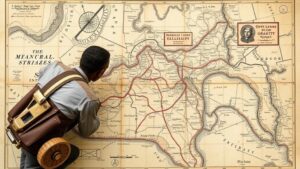Exploring Historical Freight Train Route Logs for Transportation Artifacts
Exploring Historical Freight Train Route Logs for Transportation Artifacts
This article investigates the importance of historical freight train route logs as a source of transportation artifacts, detailing how these logs reveal insights into logistics, trade patterns, and the economic conditions of their eras. The study utilizes documented railway records spanning over a century, emphasizing their contributions to historical research and transportation studies.
Introduction
The development of freight rail transport has played a pivotal role in the economic transformation of regions since the 19th century. As industries expanded and urbanization increased, railroads became the backbone of the logistics network in North America. Historical freight train route logs provide a crucial lens through which researchers can analyze trade dynamics and social changes. These logs not only track the movement of goods but also reflect the logistical practices and economic priorities of their time.
Historical Context of Freight Rail Transport
The first steam-powered train was introduced in the early 1800s, with the Locomotion No. 1 establishing a new era of freight transport in England. American railway system began developing in the 1820s, culminating in the inauguration of the Transcontinental Railroad in 1869. The significance of these advancements cannot be overstated. By the late 1800s, railroads accounted for over 70% of freight transportation in the United States, profoundly influencing the movement of agricultural and manufactured goods.
Methodology
This research employs a qualitative analysis of historical freight train route logs sourced from national archives and railway company records. study focuses on specific datasets from major railroads, including:
- Chicago and North Western Railway (C&NW) Route Logs (1890-1920)
- Pennsylvania Railroad Freight Records (1870-1890)
- Southern Pacific Railroad Shipping Logs (1900-1950)
By examining these records, the research identifies patterns in shipping routes, freight types, and seasonal fluctuations in cargo transport.
Findings
Initial findings indicate that freight route logs provide insights into the economic climate and infrastructural development of specific regions. For example, the analysis of C&NW route logs from 1890 to 1920 reveals:
- A significant increase in grain shipments during the harvest season, highlighting the railroads role in agricultural export.
- Shifts in shipping destinations that correlate with industrial growth in urban areas like Chicago and Milwaukee.
Also, the Pennsylvania Railroad records indicate marked changes in freight types over the decades, with coal shipments peaking in the late 19th century to support the burgeoning steel industry in Pennsylvania.
Impact on Economic Development
The integration of freight railways into the American economy facilitated unprecedented growth. According to the U.S. Geological Survey, the establishment of railroads led to the settlement of the Midwest, supporting the movement of resources that underpinned the industrial revolution. Between 1860 and 1900, the Midwest saw a population increase of over 200%, attributed largely to the accessibility provided by rail transport.
Transportation Artifacts and Cultural Significance
Freight train route logs are not only valuable for economic analysis; they also function as cultural artifacts that illustrate the historical significance of the railroads. They embody stories of migration, trade, and community development. For example, records of freight transport of farm goods from rural Illinois to urban centers provide insights into the agrarian lifestyle and changing dietary patterns of Americans during industrialization.
Challenges and Limitations
Despite their value, several challenges arise in analyzing historical freight train route logs:
- Inconsistent record-keeping practices across different railroads.
- Loss or degradation of documents over time.
Plus, the absence of standardized data collection methods limits the comprehensive analysis of freight trends across different regions. Future research may benefit from digitizing and standardizing freight documents to facilitate access and enhance data reliability.
Conclusion
Historical freight train route logs serve as crucial instruments for understanding the socio-economic development of regions through the lens of logistics and trade. By preserving and analyzing these documents, researchers can further illuminate the historical context of transportation systems and their impact on society. As advancements in digital archiving continue, more nuanced interpretations of these artifacts will emerge, transforming our understanding of transportation history.
Actionable Takeaways
Researchers and historians can utilize freight train route logs to:
- Explore economic trends and their implications on transportation policies.
- Analyze cultural impacts of freight transport on regional development.
- Advocate for the preservation and digitization of transportation records to enhance research access.
To wrap up, the exploration of historical freight train route logs not only enriches our comprehension of transportation history but also provides a necessary reflection on the intersections of commerce, society, and technological advancement.



